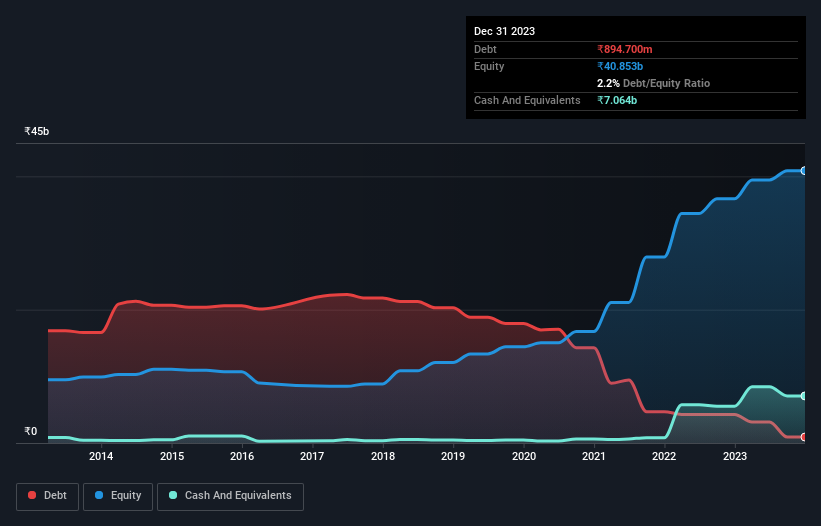- India
- /
- Metals and Mining
- /
- NSEI:GPIL
These 4 Measures Indicate That Godawari Power & Ispat (NSE:GPIL) Is Using Debt Reasonably Well
Legendary fund manager Li Lu (who Charlie Munger backed) once said, 'The biggest investment risk is not the volatility of prices, but whether you will suffer a permanent loss of capital.' So it seems the smart money knows that debt - which is usually involved in bankruptcies - is a very important factor, when you assess how risky a company is. As with many other companies Godawari Power & Ispat Limited (NSE:GPIL) makes use of debt. But is this debt a concern to shareholders?
When Is Debt Dangerous?
Debt and other liabilities become risky for a business when it cannot easily fulfill those obligations, either with free cash flow or by raising capital at an attractive price. Ultimately, if the company can't fulfill its legal obligations to repay debt, shareholders could walk away with nothing. However, a more usual (but still expensive) situation is where a company must dilute shareholders at a cheap share price simply to get debt under control. By replacing dilution, though, debt can be an extremely good tool for businesses that need capital to invest in growth at high rates of return. When we think about a company's use of debt, we first look at cash and debt together.
Check out our latest analysis for Godawari Power & Ispat
How Much Debt Does Godawari Power & Ispat Carry?
As you can see below, Godawari Power & Ispat had ₹894.7m of debt at September 2023, down from ₹4.29b a year prior. However, its balance sheet shows it holds ₹7.06b in cash, so it actually has ₹6.17b net cash.

How Healthy Is Godawari Power & Ispat's Balance Sheet?
We can see from the most recent balance sheet that Godawari Power & Ispat had liabilities of ₹6.85b falling due within a year, and liabilities of ₹2.74b due beyond that. On the other hand, it had cash of ₹7.06b and ₹2.02b worth of receivables due within a year. So its liabilities total ₹512.0m more than the combination of its cash and short-term receivables.
Having regard to Godawari Power & Ispat's size, it seems that its liquid assets are well balanced with its total liabilities. So while it's hard to imagine that the ₹99.6b company is struggling for cash, we still think it's worth monitoring its balance sheet. While it does have liabilities worth noting, Godawari Power & Ispat also has more cash than debt, so we're pretty confident it can manage its debt safely.
While Godawari Power & Ispat doesn't seem to have gained much on the EBIT line, at least earnings remain stable for now. There's no doubt that we learn most about debt from the balance sheet. But ultimately the future profitability of the business will decide if Godawari Power & Ispat can strengthen its balance sheet over time. So if you want to see what the professionals think, you might find this free report on analyst profit forecasts to be interesting.
Finally, a business needs free cash flow to pay off debt; accounting profits just don't cut it. While Godawari Power & Ispat has net cash on its balance sheet, it's still worth taking a look at its ability to convert earnings before interest and tax (EBIT) to free cash flow, to help us understand how quickly it is building (or eroding) that cash balance. Over the most recent three years, Godawari Power & Ispat recorded free cash flow worth 52% of its EBIT, which is around normal, given free cash flow excludes interest and tax. This cold hard cash means it can reduce its debt when it wants to.
Summing Up
We could understand if investors are concerned about Godawari Power & Ispat's liabilities, but we can be reassured by the fact it has has net cash of ₹6.17b. So we are not troubled with Godawari Power & Ispat's debt use. The balance sheet is clearly the area to focus on when you are analysing debt. But ultimately, every company can contain risks that exist outside of the balance sheet. For instance, we've identified 1 warning sign for Godawari Power & Ispat that you should be aware of.
Of course, if you're the type of investor who prefers buying stocks without the burden of debt, then don't hesitate to discover our exclusive list of net cash growth stocks, today.
New: Manage All Your Stock Portfolios in One Place
We've created the ultimate portfolio companion for stock investors, and it's free.
• Connect an unlimited number of Portfolios and see your total in one currency
• Be alerted to new Warning Signs or Risks via email or mobile
• Track the Fair Value of your stocks
Have feedback on this article? Concerned about the content? Get in touch with us directly. Alternatively, email editorial-team (at) simplywallst.com.
This article by Simply Wall St is general in nature. We provide commentary based on historical data and analyst forecasts only using an unbiased methodology and our articles are not intended to be financial advice. It does not constitute a recommendation to buy or sell any stock, and does not take account of your objectives, or your financial situation. We aim to bring you long-term focused analysis driven by fundamental data. Note that our analysis may not factor in the latest price-sensitive company announcements or qualitative material. Simply Wall St has no position in any stocks mentioned.
About NSEI:GPIL
Flawless balance sheet with reasonable growth potential and pays a dividend.
Similar Companies
Market Insights
Community Narratives




